Hypnosis Spiral
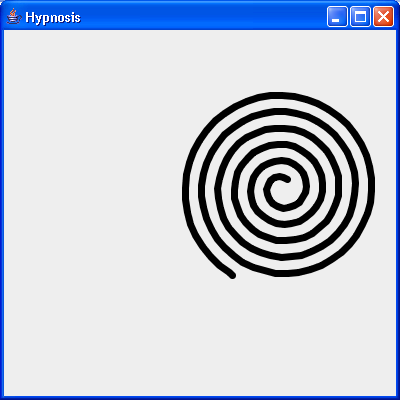
/*
* Copyright (c) 2000 David Flanagan. All rights reserved.
* This code is from the book Java Examples in a Nutshell, 2nd Edition.
* It is provided AS-IS, WITHOUT ANY WARRANTY either expressed or implied.
* You may study, use, and modify it for any non-commercial purpose.
* You may distribute it non-commercially as long as you retain this notice.
* For a commercial use license, or to purchase the book (recommended),
* visit http://www.davidflanagan.com/javaexamples2.
*/
import java.awt.BasicStroke;
import java.awt.BorderLayout;
import java.awt.Color;
import java.awt.Graphics;
import java.awt.Graphics2D;
import java.awt.Rectangle;
import java.awt.RenderingHints;
import java.awt.event.ActionEvent;
import java.awt.event.ActionListener;
import java.awt.image.BufferedImage;
import javax.swing.JComponent;
import javax.swing.JFrame;
import javax.swing.Timer;
/**
* A Swing component that smoothly animates a spiral in a hypnotic way.
*/
public class Hypnosis extends JComponent implements ActionListener {
double x, y; // The center of the spiral
double r1, r2; // The inner and outer radii of the spiral
double a1, a2; // The start and end angles of the spiral
double deltaA; // How much the angle changes each frame
double deltaX, deltaY; // The trajectory of the center
float linewidth; // How wide the lines are
Timer timer; // The object that triggers the animation
BufferedImage buffer; // The image we use for double-buffering
Graphics2D osg; // Graphics2D object for drawing into the buffer
public Hypnosis(double x, double y, double r1, double r2, double a1,
double a2, float linewidth, int delay, double deltaA,
double deltaX, double deltaY) {
this.x = x;
this.y = y;
this.r1 = r1;
this.r2 = r2;
this.a1 = a1;
this.a2 = a2;
this.linewidth = linewidth;
this.deltaA = deltaA;
this.deltaX = deltaX;
this.deltaY = deltaY;
// Set up a timer to call actionPerformed() every delay milliseconds
timer = new Timer(delay, this);
// Create a buffer for double-buffering
buffer = new BufferedImage((int) (2 * r2 + linewidth),
(int) (2 * r2 + linewidth), BufferedImage.TYPE_INT_RGB);
// Create a Graphics object for the buffer, and set the linewidth
// and request antialiasing when drawing with it
osg = buffer.createGraphics();
osg.setStroke(new BasicStroke(linewidth, BasicStroke.CAP_ROUND,
BasicStroke.JOIN_ROUND));
osg.setRenderingHint(RenderingHints.KEY_ANTIALIASING,
RenderingHints.VALUE_ANTIALIAS_ON);
}
// Start and stop the animation by starting and stopping the timer
public void start() {
timer.start();
}
public void stop() {
timer.stop();
}
/**
* Swing calls this method to ask the component to redraw itself. This
* method uses double-buffering to make the animation smoother. Swing does
* double-buffering automatically, so this may not actually make much
* difference, but it is important to understand the technique.
*/
public void paintComponent(Graphics g) {
// Clear the background of the off-screen image
osg.setColor(getBackground());
osg.fillRect(0, 0, buffer.getWidth(), buffer.getHeight());
// Now draw a black spiral into the off-screen image
osg.setColor(Color.black);
osg.draw(new Spiral(r2 + linewidth / 2, r2 + linewidth / 2, r1, a1, r2,
a2));
// Now copy that off-screen image onto the screen
g.drawImage(buffer, (int) (x - r2), (int) (y - r2), this);
}
/**
* This method implements the ActionListener interface. Our Timer object
* calls this method periodically. It updates the position and angles of the
* spiral and requests a redraw. Instead of redrawing the entire component,
* however, this method requests a redraw only for the area that has
* changed.
*/
public void actionPerformed(ActionEvent e) {
// Ask to have the old bounding box of the spiral redrawn.
// Nothing else has anything drawn in it, so it doesn't need a redraw
repaint((int) (x - r2 - linewidth), (int) (y - r2 - linewidth),
(int) (2 * (r2 + linewidth)), (int) (2 * (r2 + linewidth)));
// Now animate: update the position and angles of the spiral
// Bounce if we've hit an edge
Rectangle bounds = getBounds();
if ((x - r2 + deltaX < 0) || (x + r2 + deltaX > bounds.width))
deltaX = -deltaX;
if ((y - r2 + deltaY < 0) || (y + r2 + deltaY > bounds.height))
deltaY = -deltaY;
// Move the center of the spiral
x += deltaX;
y += deltaY;
// Increment the start and end angles;
a1 += deltaA;
a2 += deltaA;
if (a1 > 2 * Math.PI) { // Don't let them get too big
a1 -= 2 * Math.PI;
a2 -= 2 * Math.PI;
}
// Now ask to have the new bounding box of the spiral redrawn. This
// rectangle will be intersected with the redraw rectangle requested
// above, and only the combined region will be redrawn
repaint((int) (x - r2 - linewidth), (int) (y - r2 - linewidth),
(int) (2 * (r2 + linewidth)), (int) (2 * (r2 + linewidth)));
}
/** Tell Swing not to double-buffer for us, since we do our own */
public boolean isDoubleBuffered() {
return false;
}
/** This is a main() method for testing the component */
public static void main(String[] args) {
JFrame f = new JFrame("Hypnosis");
Hypnosis h = new Hypnosis(200, 200, 10, 100, 0, 11 * Math.PI, 7, 100,
2 * Math.PI / 30, 3, 5);
f.getContentPane().add(h, BorderLayout.CENTER);
f.setSize(400, 400);
f.show();
h.start();
}
}
Related examples in the same category
| 1. | Creating Basic Shapes | | |
| 2. | fillRect (int, int, int, int) method draws a solid rectangle | | |
| 3. | Creating a Shape Using Lines and Curves | | |
| 4. | Combining Shapes | | |
| 5. | Draw rectangles, use the drawRect() method. To fill rectangles, use the fillRect() method | | |
| 6. | Draw line | | 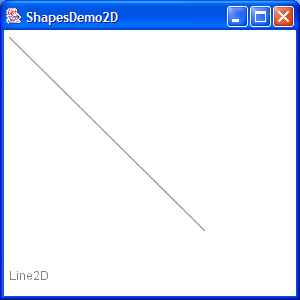 |
| 7. | Draw a Polygon | | 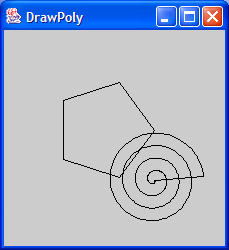 |
| 8. | Draw an oval outline | | |
| 9. | Draw a (Round)rectangle | | 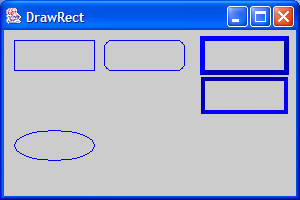 |
| 10. | Fill a polygon | | 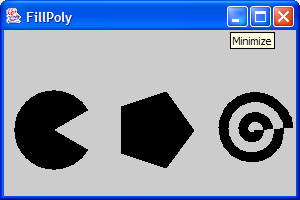 |
| 11. | Fill a solid oval | | |
| 12. | Fill a (Round)rectangle | | 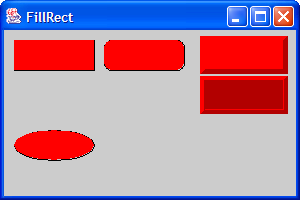 |
| 13. | Change font | |  |
| 14. | Draw rectangle 2 | | 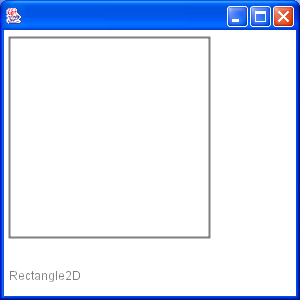 |
| 15. | Draw Arc | | 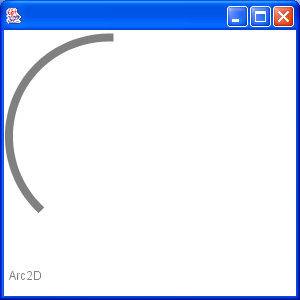 |
| 16. | Draw Ellipse | | 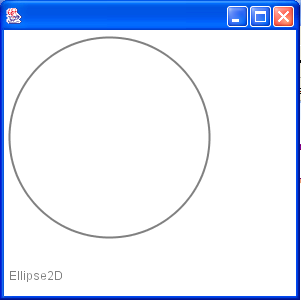 |
| 17. | Fill a Rectangle 2 | | 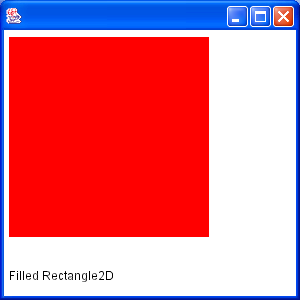 |
| 18. | Fill Arc 2 | | 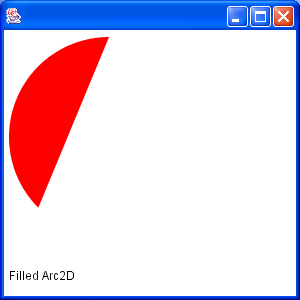 |
| 19. | Draw text | |  |
| 20. | Draw unicode string | | 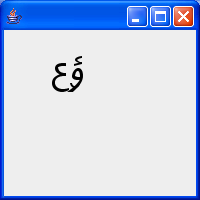 |
| 21. | Shape combine | | 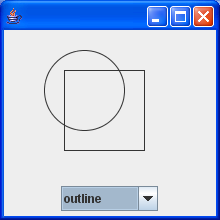 |
| 22. | Effects | | 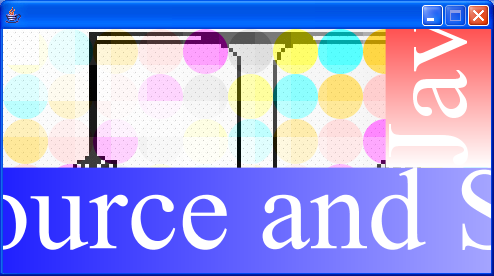 |
| 23. | Mouse drag and drop to draw | | 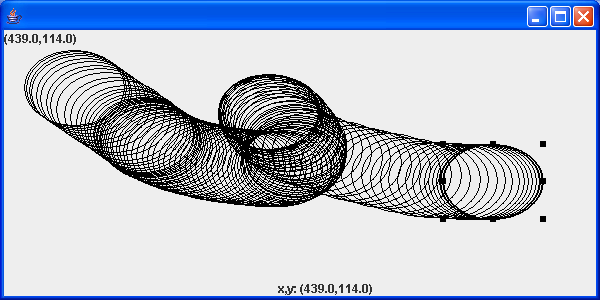 |
| 24. | Arc demonstration: scale, move, rotate, sheer | | 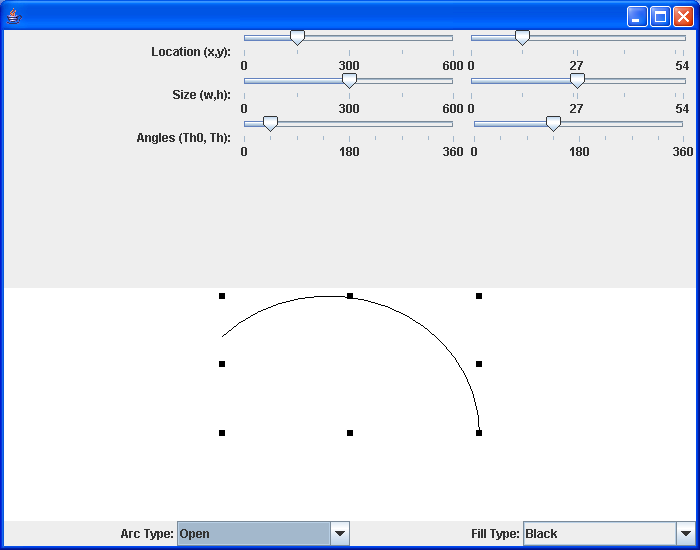 |
| 25. | GlyphVector.getNumGlyphs() | | |
| 26. | Resize a shape | | |
| 27. | Rectangle with rounded corners drawn using Java 2D Graphics API | | |
| 28. | Compares two ellipses and returns true if they are equal or both null. | | |
| 29. | Compares two lines are returns true if they are equal or both null. | | |
| 30. | Creates a diagonal cross shape. | | |
| 31. | Creates a diamond shape. | | |
| 32. | Creates a new Stroke-Object for the given type and with. | | |
| 33. | Creates a region surrounding a line segment by 'widening' the line segment. | | |
| 34. | Creates a triangle shape that points downwards. | | |
| 35. | Creates a triangle shape that points upwards. | | |
| 36. | Generate Polygon | | |
| 37. | Polygon with float coordinates. | | |
| 38. | Polyline 2D | | |
| 39. | Serialises a Shape object. | | |
| 40. | Tests two polygons for equality. If both are null this method returns true. | | |
| 41. | Union two rectangles | | |
| 42. | Calculate Intersection Clip | | |
| 43. | Draws a shape with the specified rotation about (x, y). | | |
| 44. | Checks, whether the given rectangle1 fully contains rectangle 2 (even if rectangle 2 has a height or width of zero!). | | |
| 45. | Reads a Point2D object that has been serialised by the writePoint2D(Point2D, ObjectOutputStream)} method. | | |
| 46. | Returns a point based on (x, y) but constrained to be within the bounds of a given rectangle. | | |
| 47. | RectListManager is a class to manage a list of rectangular regions. | | |
| 48. | Fill Rectangle2D.Double and Ellipse2D.Double | | 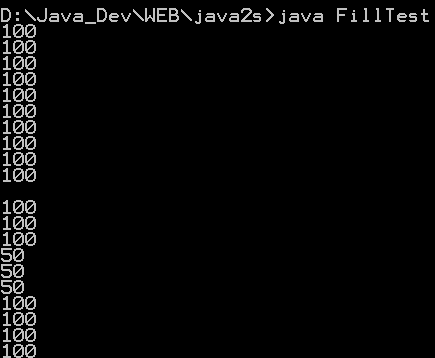 |
| 49. | This program demonstrates the various 2D shapes | | 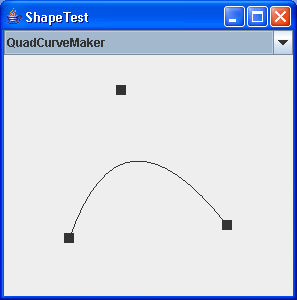 |